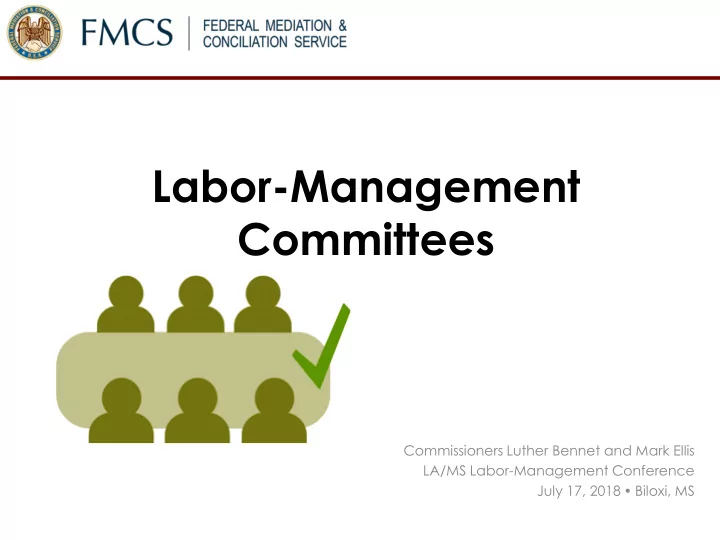

Labor-Management Committees Commissioners Luther Bennet and Mark Ellis LA/MS Labor-Management Conference July 17, 2018 Biloxi, MS
Today’s Plan • Overview of Labor-Management Committees • Break into smaller groups and work a problem • Groups will report out • Summarize and distribute written material
Labor-Management Committee • A joint committee that brings representatives of both the Company and the Union into regular communication and contact over subjects of mutual interest. • LMC’s provide an ongoing forum to deal with common problems.
LMC Guidelines • MEMBERSHIP – Should be composed of the leadership of Labor and Management (those who interact with each other). • NUMBERS – Should be relatively equal and limited to three to five members each, from both Labor and Management. Larger groups tend to be less effective.
LMC Guidelines • MEETINGS – Usually held once each month for one or two hours at a predetermined time and place. Meetings should begin on time and end on time. • AGENDA – Most effective when a written agenda is prepared in priority order by each group, then alternately merged and provided to each member in advance, usually 2-5 days.
LMC Guidelines • MINUTES – Written minutes should be taken in summary form only, and communicated to the membership and other managers, but only after approval by each group. • CHAIRPERSON – Normally alternated between Labor and Management. An FMCS Mediator can serve as a facilitator at the beginning until parties become comfortable with the LMC process.
LMC Guidelines • RESTRICTIONS – Active grievances are not appropriate in the LMC. – LMC may deal with problems that could be the cause or reason or subject of a grievance that is not yet active. – An LMC is not the appropriate vehicle for actual modification of the Labor Agreement.
LMC Guidelines • SKILLS – Most LMC’s function best using brainstorming, problem solving techniques and consensus. – Decisions based on information, communication, exploration, then consensus, eliminates them as a source of irritation and creates a “buy in” of the solution for both groups.
LMC Guidelines • PURPOSE – The objectives of an LMC are to improve the communication and understanding between the parties, and to solve problems in a non-adversarial environment. – LMC’s can have a positive impact on your day -to-day relationship.
LMC Keys for Success • Willingness • Desire • Commitment • Expectations
LMC – Keys for Success A F A Foundation undational al Principle Pr nciple for r La Labor bor-Manage anageme ment nt Pa Partnersh tnerships ips
How do you get started? • Exercise: Setting up an LMC 1) You will be given a situation with relevant contract language a) Healthcare Cost going higher b) Job Rotation and Plant Re-alignment c) Progression Training d) Safety e) Staffing the facility 2) Divide into groups of approximately 15 3) Work as a group to answer the questions on the next slide 4) Select a person to report out 5) We will have pamphlets for those participating at the end! 6) Slides will be available on the “Agenda” tab of the Conference Website
How do you get started? • Questions to be considered for your start-up 1) What are the objectives for the group? 2) If you need additional experts, who are they? 3) 5 ground rules 4) Goals to be achieved in six months 5) Goals to be achieved in one year 6) Metrics/benchmarking established to “we are not meeting just to be meeting”
Recommend
More recommend